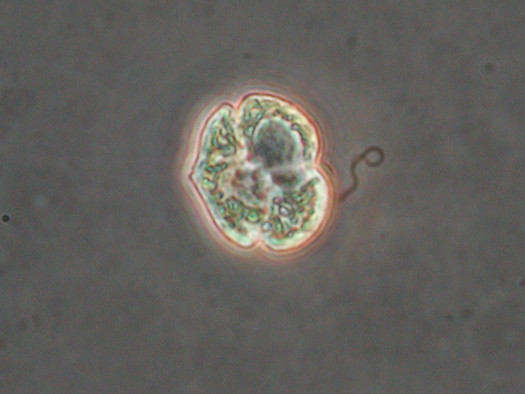
Harmful Algal Blooms
There are thousands of species of algae — phytoplankton — in fresh and marine waters worldwide. They are essential to life as we know it, forming the basis of the food web and providing an important source of the oxygen we need to breathe. While most species are harmless to humans and animals, some are toxic. When these species multiply — creating harmful algal blooms (HABs) — they can wreak havoc on human and marine animal health, contaminate seafood and devastate local economies.
In the Gulf of Mexico, two common species that cause problems for communities are Karenia brevis and Dinophysis ovum. Toxins from these species accumulate in shellfish that — if ingested by humans — can cause neurotoxic shellfish poisoning (Karenia) or diarrhetic shellfish poisoning (Dinophysis), resulting in severe gastrointestinal distress and even neurological symptoms. Karenia can also cause respiratory impacts in humans — especially those with underlying chronic lung disease.
Gulf of Mexico HABs can also kill other marine species and have severe negative impacts on quality of life for humans.
Thanks to research, we know that HABs are becoming more frequent, more toxic, longer lasting and more widespread. While we cannot eliminate them, we have developed tools to monitor their movement and geographic spread and predict their negative consequences to help manage their impacts on communities.
HAB-Related Products
Harmful Algal Bloom Integrated Observing System (HABIOS) Plan
A Primer on Gulf of Mexico Harmful Algal Blooms
Imaging Flow Cytobot (IFCB)
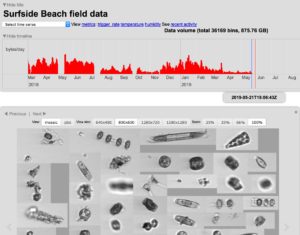 The IFCB is a tool developed by scientists at Woods Hole Oceanographic Institution that combines a flow cytometer with video imaging and pattern recognition software to automate detection of algae species. Texas A&M University has deployed the IFCB in Texas to provide a vital early warning system that keeps people healthy.
The IFCB is a tool developed by scientists at Woods Hole Oceanographic Institution that combines a flow cytometer with video imaging and pattern recognition software to automate detection of algae species. Texas A&M University has deployed the IFCB in Texas to provide a vital early warning system that keeps people healthy.
The Texas Parks and Wildlife Department and the Texas Department of State Health Services use alerts from the IFCB to ensure harvested shellfish are safe to eat, beach experiences are enjoyable and to investigate marine wildlife die-offs. NOAA also includes IFCB data in HAB Bulletins for Texas.
Who is this product for?
Primarily used by researchers and resource managers to protect public health.
Features
- Hourly time series plots
- Cell counts
HABscope
HABscope was developed by GCOOS in partnership with NOAA, the Florida Fish and Wildlife Research Institute and other partners to create a field-ready tool that could further automate the detection of Karenia brevis, the organism that causes red tide in the Gulf of Mexico, in water samples. Researchers took a low cost, classroom-grade, 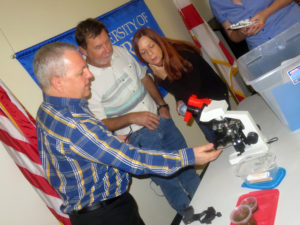 portable microscope, outfitted it with a special adaptor — designed by the team’s engineer and printed on a 3D printer — then used that piece to mount an Apple iPOD touch to the eyepiece of the microscope. A portable power pack provides the power to light the microscope.
portable microscope, outfitted it with a special adaptor — designed by the team’s engineer and printed on a 3D printer — then used that piece to mount an Apple iPOD touch to the eyepiece of the microscope. A portable power pack provides the power to light the microscope.
Open-source machine-learning software (TensorFlow) was used to build a model that would help the computer automatically identify Karenia brevis cells in the water sample as well as the number of cells present — the concentration of cells. Then, cell counts can be quickly provided to researchers making red tide forecast models and can be shared with the public for more accurate reports about whether red tide is impacting a local beach and whether the concentrations are high enough to warrant a public health concern. In all, it took some 58,819 images of K. brevis cells to develop the model and “teach” the computer to recognize red tide.
Who is this product for?
Primarily used by researchers to predict or understand red tide impacts in the Gulf of Mexico.
Red Tide Respiratory Forecast
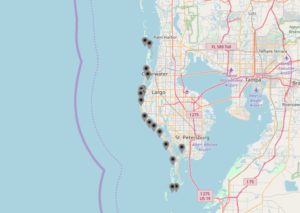 This operational forecast provides a risk-level forecast for red tide respiratory impacts on Florida and Texas beaches when red tide blooms are occurring. The 24-hour Red Tide Respiratory Forecasts are updated every three hours, following the collection and analysis of water samples.
This operational forecast provides a risk-level forecast for red tide respiratory impacts on Florida and Texas beaches when red tide blooms are occurring. The 24-hour Red Tide Respiratory Forecasts are updated every three hours, following the collection and analysis of water samples.
Who is this product for?
Gulf Coast residents and visitors who want to know if the beach they are planning to visit is being impacted by Florida red tide. Resource managers and researchers will also find this information helpful.
Features
The Experimental Red Tide Forecast is provided in three-hour increments projected out over a 24-hour period and includes other details like wind speed and direction. It lists the risk level as:
- Absent/Very low: Meaning there is a low risk of irritation among most beachgoers but that people with lung disease should leave the area if they begin feeling impacts.
- Low: A low risk of irritation among most beachgoers but that people with lung disease should leave the area if they begin feeling impacts.
- Moderate: Moderate risk of irritation for most people; people with lung disease should avoid this area.
- High: High risk of irritation for most people; people with lung disease should avoid this area.
Beach Conditions Reporting System
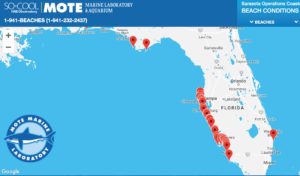 The BCRS provides daily updates on waves, currents, water and air temperature, algae, red tide and multiple other conditions at 38 Florida beaches, including Lake Worth on Florida’s east coast and 37 beaches on the Gulf Coast. Each beach is monitored by trained volunteers including lifeguards, park rangers and others in a service coordinated by Mote Marine Laboratory.
The BCRS provides daily updates on waves, currents, water and air temperature, algae, red tide and multiple other conditions at 38 Florida beaches, including Lake Worth on Florida’s east coast and 37 beaches on the Gulf Coast. Each beach is monitored by trained volunteers including lifeguards, park rangers and others in a service coordinated by Mote Marine Laboratory.
Who is this product for?
Beachgoers and coastal residents interested in knowing what the conditions are at the beach they plan to visit before they leave home.
Features
- Information on whether red tide is currently occurring at a particular beach
- Information on multiple other beach conditions
Also available as an app in the App story or on Google Play (search for Mote BCRS User)
Programmable Hyperspectral Seawater Scanner (PHYSS)
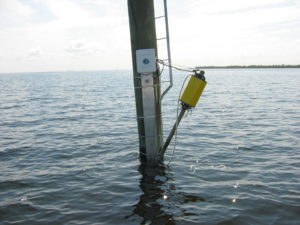 PHYSS is a next-generation marine spectrophotometer under development by the Ocean Technology Group at Mote Marine Laboratory. Based on an earlier device, the Optical Phytoplankton Discriminator (OPD — also known as the BreveBuster), the PHYSS performs automated sampling and analysis of seawater to detect the presence of various pigments associated with harmful algae blooms, such as Karenia Brevis. Unlike the OPD, the PHYSS can be programmed by users, allowing far greater flexibility in both the sampling procedure and the analysis of the resulting data. In addition, it supports an extended hardware configuration, which allows two chemical reagents to be mixed with seawater samples prior to optical spectrum acquisition.
PHYSS is a next-generation marine spectrophotometer under development by the Ocean Technology Group at Mote Marine Laboratory. Based on an earlier device, the Optical Phytoplankton Discriminator (OPD — also known as the BreveBuster), the PHYSS performs automated sampling and analysis of seawater to detect the presence of various pigments associated with harmful algae blooms, such as Karenia Brevis. Unlike the OPD, the PHYSS can be programmed by users, allowing far greater flexibility in both the sampling procedure and the analysis of the resulting data. In addition, it supports an extended hardware configuration, which allows two chemical reagents to be mixed with seawater samples prior to optical spectrum acquisition.
Who is this product for?
Researchers and resource managers tracking the presence of harmful algal blooms, particularly the red tide caused by Karenia brevis.
Features
- Pigment readings from water samples indicating which species of phytoplankton are present.














